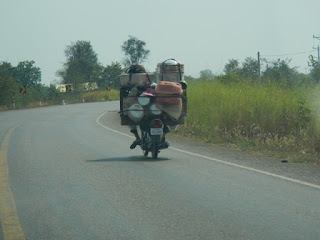 |
| Your two Shamrock racers in fron of the Temple at Angkor Wat...Burma |
 |
| The Temple Banyou at Angkor Wat....Burma |
The temples are built of sandstone, which was quarried about 40 km from the temple sites. The large sandstone blocks were transported to the temple sites on bamboo rafts floated and pulled by men from the banks of a local river and a series of canals constructed to move all this building material. It is hard to imagine the complexity of these structures and the amount of math, geometry, engineering that these ancient people must have had to do this type of construction.
Shortly after 1400, the kings and government ministers left the area of Siem Reap as a result of an invasion by Thailand, which defeated the local population of about 1M+ people. Almost the entire population of Siem Reap moved to Phnom Penh which is the current capital of Cambodia. The temples were completely abandoned (except for a few monks) and forgotten. The jungles grew up around (and in some cases through) the temples and they weren't "re-discovered" until the 1850s. The Frenchman, Henri Mouhot, was one of the first westerners to re-discover these temples and he wrote that they were grander than anything left us by the Greeks or the Romans.
I will close by saying that Angkor Wat is one of the greatest structures man has ever built.......and a must see for anyone who wants to understand the accomplishments of ancient man.
 |
| The forest has overgrown this temple and the curators have left it as they found it. |
 |
| The backside of the Temple at Angkor Wat....Burma |
 |
| The Temple Banyou at Angkor Wat....Burma |
 |
| Large Buddha built on a hill in the forest...Thailand |
Second Observation:
 |
| A local Mitchel utensil salesman...Burma |
Long after the pullout by the Americans and the defeat of the South Vietnamese, the Khmer Rouge remained in power and installed a regime of fear, killing and regression. The regime led by Pol Pat, killed about 2-3M of his countrymen (about 25% of the entire population). They were finally thrown out after a war between Cambodian and the by-then unified Vietnam. There is not a family today in Cambodia that doesn't have a story about a family member that was killed or jailed by the Khmer Rouge.
It is not an exaggeration to say that the ethnic cleansing carried out by the Khmer Rouge was the worse human tragedy since the Holocaust of World War II.
This band all suffered sever injuries from land mines. They earn a living to support their families by playing at the Jungle Temple.
It left the country poor. All of their elites, their educated class and their entire merchant class were exterminated by the Khmer Rouge.
We, in the West, forget that China, today, has the largest middle-class, by absolute numbers, in the world. Today, China has a middle class of 200M (out of a population of 1.3B). Those 200M want the same goods and services that all middle class people want........homes, cars, education for their children, travel, good medical care.....and especially, a long life.
I've said before in these blogs.....the next century will be the Chinese Century and all of the rest of us need to figure out how to compete with them and co-exist with them....all at the same time.


